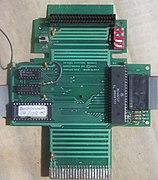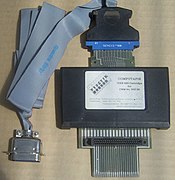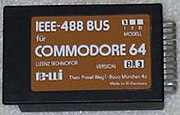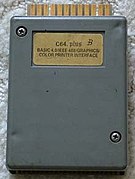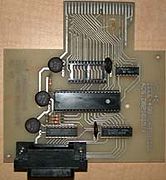Commodore D9060
MFM[1] | |
| Connectivity | IEEE-488 |
|---|---|
| Backward compatibility | Commodore PET, With special interfacing also VIC-20 and Commodore 64 |
The Commodore D9060/D9090 Hard Disks were the only family of
Technical data
| Model | Mechanism type | RPM | Heads | Cylinders | Sectors | Bytes/sector | Unformatted size | Formatted size | Blocks free | Free |
|---|---|---|---|---|---|---|---|---|---|---|
| D9060 | TANDON TM602S | 3600±1%[2] | 4[3] | 153[3] | 32 | 256 | 6.4 MB | 5.01 MB | 19,442 | 4860.5 KB |
| D9090 | TANDON TM603S | 3600±1%[2] | 6[3] | 153[3] | 32 | 256 | 9.6 MB | 7.52 MB | 29,162 | 7290.5 KB |
- on the D9060; 153 Cylinders × 4 Heads × 32 Sectors × 256 Bytes/sector equals 5.01 MB.
- on the D9090; 153 Cylinders × 6 Heads × 32 Sectors × 256 Bytes/sector equals 7.52 MB.
Internally the system was made up of four major parts:
- CBM DOS 3.0 PCB
- SASI Controller
- Hard drive
- Power supply
Input voltage: 100, 117, 220, 240 V AC
Power supply
4-pin plug & cable - wiring and voltages follow world standard for large drive power cables, but colours are not standard.
| Pin | Usage |
|---|---|
| 1 | 5 V |
| 2 | Ground (black) |
| 3 | Ground (black) |
| 4 | 12 V |
CBM DOS 3.0 PCB
This DOS PCB is made up of several major electronic components:
- 3 × ROMs (Two for CBM DOS system & communication with host computer, one for SASI communications for hard drive low level formatting - track & sector layout, 4 or 6 heads.)
- 4 or 6 heads is selectable by a hardware jumper located on the front of the DOS PCB[4]
- 2 × MOS 6502 microprocessors @ 1 MHz
- 2 × 6532 RIOT I/O chips
- 1 × 6522 VIA I/O chip
- 8 × 2114 SRAM chips 4 KB DOS use, system disk buffers
- Commodore device number selectable between 8 - 11 (on IC 7H : 6532)
SASI controller

The main brain driving this controller is the AMD 'AM2910' (a 12-bit address sequencer) The SASI interface was invented by Shugart which would later become Seagate. SASI eventually became standardized and is known today as SCSI.
Connecting two hard drives to one SASI controller
Capable of managing 2 x
Hard drive

The unit uses Tandon TM602S/TM603S hard disk drive units. Tandon was founded in 1975[5] and became part of Western Digital (WD) in 1988.[6]
Data is encoded to the disk platters using the MFM disk format.[7]
Internally the system had a transfer rate of 5.0 Mbit/s from the hard disk drive to the CBM DOS 3.0 Controller PCB.
Any 4 or 6 head MFM drive mechanism can be used as a replacement mechanism.[citation needed]
Cylinders = 153 (per hard disc) 6 head drive contains 3 platters, 4 head drive contains 2 platters.
Sectors per cylinder = 192 (D9090) (32 sectors × 6 heads)
Sectors per cylinder = 128 (D9060) (32 sectors × 4 heads)
Sectors per track = 32
Bytes per sector = 256
Access time Track-to-Track, Average: 153 ms, 99 ms[2]
Error Rates:[2] Soft Read: 1×1010 bits Hard Read: 1×1012 bits Seek Errors: 1×106 seeks
Recording density: 7690 BPI (bits per inch)[2]
Transfer speed: 5 Mbit/s[2]
+12V D. C. +/- 10% 1.5 amps tyical, 5 amps maximum for 10 seconds with no more than 5 millivolts PARD*[2] +5V D. C. +/- 5% .. 8 amps typical with no more than 50 millivolts PARD*[2]
- Periodic and Random Deviation.
Environmental: Ambient Temperature: Operating: 16 °C to 46 °C (50°F to 115°F) Nonoperating: -35.4°C to 60 °C (-40°F to 140°F) Relative Humidity: 8% to 80% Maximum Wet Bulb Temperature: 26 °C without condensation[2]
True: 0.0 - 0.4 V Imax=40mA maximum[2] False: 2.5-5.25 V Imax=0mA open[2]
Control signal electrical for single ended signals: 7438 driver into a maximum of 20 feet (6.1 m) cable into a +5V..220 ohm..Signal..330 ohm terminator..GND into a 74LS14 load.[2]
Formatting
Despite the small storage space (by current standards) of these legacy hard drives, formatting either can require a fair amount of patience from the user:
- D9060 (4 heads) Formatting takes approximately 1 hour.
- D9090 (6 heads) Formatting takes approximately 1 hour and 20 minutes.
These long delays can be attributed by the overall operation which consists of the low-level disk format by the SASI controller, followed by a six-pass test pattern write to the whole disk surface by the DOS before placing the initial filing system information.
Partitions and subdirectories
Due to the structure of the onboard DOS 3.0, there is only one main partition which contains the directory and all the saved files. There are no subdirectories so eventually you run into trouble when you type LOAD"$",8 and LIST, the directory list fills the screen and then scrolls away. You can pause the directory listing as with any Commodore computer. But if you have scores or hundreds of files saved, then the user must wait some time until the entire directory listing has finished scrolling.
Using larger disk mechanisms
With minor changes to the CBM DOS ROM code, larger capacity hard disk drives could be swapped into the D9060/D9090 unit. This was done by finding drives with 8 heads (4 platters) and 256 cylinders. The CBM DOS would support these numbers if "hard coded" into the ROM. Nothing larger could be accommodated without major changes to the drive code. In the 1980s, an Arizona company named Copperstate Cash Register was selling upgraded units to the business and BBS operator community.[8]
| Model | Mechanism type | RPM | Heads | Cylinders | Sectors | Bytes/sector | Actual | Formatted size | Blocks free | Free |
|---|---|---|---|---|---|---|---|---|---|---|
| D9060-modified | Unknown | 3600 | 8[3] | 256[3] | 32 | 256 | 16.8 MB | ~12.0 MB | Unknown | Unknown |
- 256 Cylinders × 8 Heads × 32 Sectors × 256 Bytes/sector equals 16.8 MB.
IEEE–488 bus
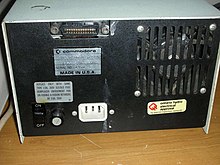
The drive used the IEEE–488 interface (24 wire parallel cable) to communicate with computers (also known as both the General Purpose Interface Bus (GPIB) and the Hewlett-Packard Interface Bus (HP-IB)). The transfer rate was 1.2 kB per second from the D9060/D9090. These hard drives can be daisy chained on the interface with each device using a different device number.
The D9060/D9090 were designed for use on the Commodore CBM/PET family of computers, but because these metal-cased family of computers were obsoleted by the VIC-20 and the Commodore 64, the greatest demand for these drives came from the biggest home computer user market in the world at the time, the VIC-20, C64 and C128 users.[citation needed] As a result, several companies built interfaces that effectively give a VIC-20 and Commodore 64/128 an IEEE-488 port. The first produced was the VIC-20 IEEE 488 cartridge, model number "VIC-1112", produced by Commodore.
Commodore 64 IEEE-488 interface cartridges were made by various companies. The original Commodore 64/128 IEEE Cartridge was produced later and were packaged with
- Batteries Included - Buscard II Interface. (contains a PROM)
Some other interfaces without pictures available:
- E-LINK Serial to IEEE Interface. (contains 65C02, 6522 and 4 KB ROM)
- INTERPOD - A standalone interface box, that connects the
- MSD VIE ("VIC20 - 488") - 4 KB 2716 EPROM 6522 VIA, 75160A & 75161A IEEE drivers.
- MSD CEI ("C64 - 488") - 4 KB 2716 EPROM 6526 CIA, 75160A & 75161A IEEE drivers.
- Richvale Telecommunications (RTC) - C64-LINK - 6821 PIA, EPROM[11]
- Richvale Telecommunications (RTC) - C64-LINK II - 6821 PIA, EPROM[12][13]
Commodore 64/128 usage
The D9060 & D9090 hard drives were highly sought after in the early 1980s by people using the Commodore 64 and Commodore 128 who wanted to taste the luxury of having all their utilities and games in one place. Files and games loaded 5 times faster than the common Commodore 1541 floppy disk drive. Many bulletin board systems (BBS) were set up using these hard drives as they could access information quickly and could hold massively more information compared to the 1541 disk drive which could only access 170 KB on one side of a floppy disk at one time.
By the late 1980s, the Commodore 64 had obsoleted all other Commodore 8-bit machines mainly because of the sheer number of users worldwide and also the market support from so many 3rd party software & hardware companies. As a result, the older IEEE-488 disk drives and hard drives were being acquired by large numbers of C64 owners to connect to their computer using an IEEE-488 Interface. This has put pressure on the supply of these devices as nowadays they are wanted by both Commodore 64/128 users and also needed by people using the PET family of machines, that these drives were specifically designed for.[citation needed]
Price when new
The oldest pricing reference found for this article was titled "Commodore Price List 1-september 1983"
- D9060 Hard Disk Drive 5 Megabytes = $4,648 (Australia), £1,995 (UK)
- D9090 Hard Disk Drive 7.5 Megabytes = $5,813 (Australia), £2,495 (UK)
References
- ^ a b "harddisk.asc". 1994-01-03. Retrieved 2016-04-28.
Manufacturer Type UF-Cap. F-Cap. Interfa Modula Cylind Heads Sector Acces Transf RPM Buffer Format ; Tandon TM603S ? 7 ST506 MFM 153 6 17 98 0.6 0 ? ?
- ^ a b c d e f g h i j k l Tandon OEM operating and service manual (1982)
- ^ a b c d e f "Hard Drive Specifications". 2008-05-16. Retrieved 2016-04-28.
- ^ "Commodore D9090 & D9060 Hard Drive - Technical info".
- ^ Company profile, CIO, June 1991
- ^ O'Dell, John (May 24, 1988). "Western digital bought patent problems when it acquired hard disk operation". Los Angeles Times.
- ^ "Disk Drive Performance Characteristics - Tandon TM602S Operating And Service Manual". 20 Sep 1982.
- ^ Yara, Georgann. "Change of heart continues family business". The Arizona Republic. Retrieved 2021-11-30.
- ^ "Commodore C64 IEEE–488 Cartridge : Giving the C64 some PET Power!". www.zimmers.net. Retrieved 2019-06-09.
- ^ "Interpod IEEE-488 Interface". April 2008. Retrieved 2016-04-28.
- ^ "Ad: C64-LINK" (PDF). April 1983. Retrieved 2020-04-27.
- ^ "User Manual: RTC C64-LINK by David Foster" (PDF). Retrieved 2020-04-27.
- ^ "Ad: C64-LINK" (PDF). April 1983. Retrieved 2020-04-27.
1. The Commodore D9090/D9060 Users Guide.
2. The Commodore D9090/D9060 Workshop Repair manual.
- InfoWorld 27 sep 1982, page 89, Wholesale suppliers, Division of B O S S Post Office Box 22428 Carmell, California 93922 Write or Call (408) 373-0320 24 Hrs. sells a: "TM603 10 MB Winchester drive, 9.5 MB unformatted capacity, 254 TPI, 153 cylinders, 918 tracks, 3 platters, 6 heads ... $910.00" with 90 Day Warranty (One (1) Year Available) on Drives
- manualslib.com: Tandon OEM operating and service manual Model numbers TM602S, TM603S,AND TM603SE 5.25" rigid disk drives September 20, 1982



